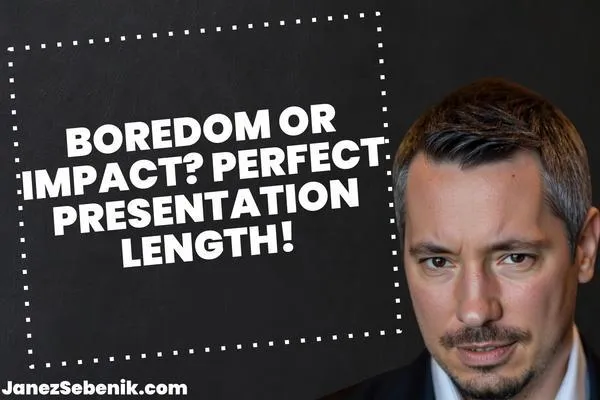
How long should a sales presentation last?
You're about to give a sales presentation. Your palms are sweaty. You're wondering how long to talk. Don't worry, we've got you covered.
The ideal sales presentation should last between 20 to 45 minutes. This gives you enough time to make your pitch without losing your audience's attention.
Remember, your goal isn't to talk for hours. It's to close the deal. Keep it short, sweet, and focused on your value proposition. Your potential clients will thank you for respecting their time.
Key Takeaways
Keep your sales presentation between 20-45 minutes to maintain interest
Tailor your presentation length to your audience and their needs
Use visuals and interactive elements to boost engagement during your pitch
Understanding Your Audience
Knowing your audience is key. It helps you tailor your pitch and hit the right notes. Let's dive into how to do that effectively.
Identifying Pain Points
You gotta find out what keeps your potential customer up at night. What's their biggest headache? Maybe it's high costs, low efficiency, or crappy customer service.
Ask questions. Listen hard. Don't just hear their words, feel their frustration.
Once you know their pain, you can show how your product is the aspirin they've been searching for. It's not about features. It's about solutions.
Make a list of common industry problems. Check which ones resonate with your audience. Bam! You've got your talking points.
Customizing for Customer Needs
Now that you know what bugs them, it's time to tailor your pitch. Every customer is unique. Treat them that way.
Highlight your differentiators that matter to them. If they care about speed, show how you're faster. If it's quality, prove you're the best.
Don't drone on about stuff they don't care about. Keep it relevant. Keep it punchy.
Use their language. Mimic their style. If they're formal, button up. If they're casual, loosen that tie.
Remember, it's not about you. It's about them. Show how you solve their specific problems. That's how you win.
Crafting Your Message
Your message is the heart of your sales pitch. It needs to be clear, compelling, and tailored to your audience's needs. Let's break down how to craft a message that hits home.
Developing a Clear Value Proposition
Your value prop is your secret sauce. It's what sets you apart from the competition. Ask yourself: What problem do you solve? How do you make your customers' lives better?
Keep it simple. Boil it down to one sentence. Something like: "We help busy professionals save 10 hours a week." That's a value prop that sticks.
Use concrete numbers when you can. They add credibility. "Our software cuts reporting time by 50%" is way more powerful than "Our software saves time."
Test your value prop on someone outside your industry. If they get it, you're on the right track.
Structuring Your Presentation
Structure is your roadmap. It guides you and your audience from point A to sold. Start with a hook. Grab their attention right out of the gate.
Then, outline the problem. Make them feel it. Next, introduce your solution. Show how it solves their pain points.
Back it up with proof. Case studies, testimonials, data - whatever you've got. Incorporate a compelling story to make your pitch more relatable.
End with a clear call to action. Tell them exactly what you want them to do next. Don't leave them guessing.
Remember, keep your visuals clean and simple. They should support your message, not distract from it.
Presentation Design Insight
Your slides can make or break your sales pitch. Good design grabs attention and helps your message stick. Bad design puts people to sleep faster than warm milk.
Creating Compelling Graphics
Want to keep eyes on you instead of phones? Use killer graphics. Visual aids are your secret weapon.
Ditch the boring clip art. Go for custom images that pop. Use charts and graphs to make numbers sexy. Infographics can turn dry facts into eye candy.
But don't go overboard. Too many flashy graphics = sensory overload. Keep it clean and focused. Each slide should have one main point, not War and Peace.
Pro tip: Use high-quality stock photos if you're on a budget. Just avoid the cheesy ones with people in suits shaking hands.
Utilizing Effective Slide Design
Your slides are billboards, not novels. Keep 'em simple. Three minutes per slide is the sweet spot.
Use a consistent color scheme. It should match your brand, not give people seizures. Stick to 2-3 main colors max.
Font matters. Use big, readable text. If your audience needs binoculars, you're doing it wrong.
White space is your friend. Don't cram every pixel with info. Give your content room to breathe.
Align elements neatly. Sloppy design screams amateur hour. Use grids to keep things tidy.
Remember, your slides support you. You're the star, not your PowerPoint. Keep it simple and let your personality shine through.
Practical Presentation Tips
Want to nail your sales pitch? These tips will help you keep it tight and tell a story that sells. No fluff, just the good stuff.
Keeping It Short and Sweet
You've got 20 minutes max. Use 'em wisely. Cut the fat from your pitch.
Focus on what matters to your prospect. Don't bombard them with every feature you've got. Pick the top 3 that'll solve their problems.
Use visuals, not walls of text. A picture's worth a thousand words, right? So use 'em.
Practice your timing. Run through it until you can hit that sweet spot every time. Remember, less is more in an effective sales presentation.
Incorporating Storytelling
Stories sell. Period. They're how we're wired. Use that to your advantage.
Start with a problem your customer faces. Make it real. Make it hurt. Then swoop in with your solution.
Use case studies. Show how you've helped others just like them. It's not bragging if you can back it up.
Keep it relevant. Your story should tie directly to what you're selling. No random anecdotes about your cat.
End with a clear call to action. What do you want them to do next? Tell 'em. Make it easy for them to say yes.
Execution and Delivery
Nailing your pitch is all about mastering delivery and engaging your audience. Let's dive into how you can crush it and leave a lasting impression.
Mastering the Art of the Pitch
Your sales deck is your secret weapon. Keep it simple and visually appealing. No one wants to read a novel on slides.
Focus on value. What's in it for them? Paint a picture of how their life gets better with your product.
Practice, practice, practice. Record yourself and watch it back. Yeah, it's awkward, but it works.
Use presentation templates to save time. But don't let them make you boring. Add your own flair.
End with a bang. Your call-to-action should be clear and compelling. Make it easy for them to say yes.
Handling Audience Interaction
Embrace questions. They're not interruptions, they're opportunities to shine.
Listen more than you talk. Your prospects will tell you exactly what they need if you let them.
Got a tough question? Don't BS. If you don't know, say you'll find out and get back to them.
Use objections as stepping stones. They're just telling you what they need to hear to say yes.
Remember, it's a conversation, not a monologue. Engage them, get them nodding along with you.
Keep it light. A well-timed joke can break tension and make you more relatable. Just don't overdo it.
Sales Presentation Tools
Good tools make sales presentations easier and more effective. Let's look at some key resources to help you shine in your next pitch.
Choosing the Right Templates
You need a killer template to make your pitch pop. Don't start from scratch - use pre-made templates to save time and look pro.
Sales presentation templates come in all shapes and sizes. Pick one that fits your brand and message. Look for clean designs with plenty of white space.
Some templates focus on data visualization. Others highlight customer stories. Choose based on what you're selling and who you're talking to.
Customize your template. Add your logo, colors, and fonts. Make it yours. But don't go crazy - keep it simple and clean.
Leveraging Sales Deck Examples
Wanna see what works? Check out sales deck examples from top companies. They'll give you ideas for your own pitch.
Look at decks in your industry. See how they structure their story. What visuals do they use? How do they present data?
Don't copy - get inspired. Take the best ideas and make them your own. Maybe you like how one deck uses customer quotes. Or how another presents pricing options.
Study decks from companies you admire. What makes them effective? Is it the design? The content? The flow? Learn from the best to become the best.
Introduction
Hey, champ! You're about to nail your sales presentation.
Let's start with a clear agenda. It's like a roadmap for your pitch. No one likes getting lost, right?
Use a killer sales presentation outline. It's your secret weapon to stay on track and hit all the important points.
When you present the solution, make it pop. Show them how you're gonna solve their problems like a boss.
And don't forget those sales presentation tips. They're the difference between a "meh" pitch and a "holy cow, take my money" moment.
Now go out there and crush it. Your perfect sales presentation is waiting to happen. You've got this!
